Effective Ways to Keep Whole Avocados Fresh
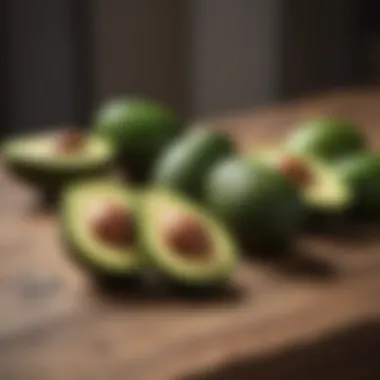
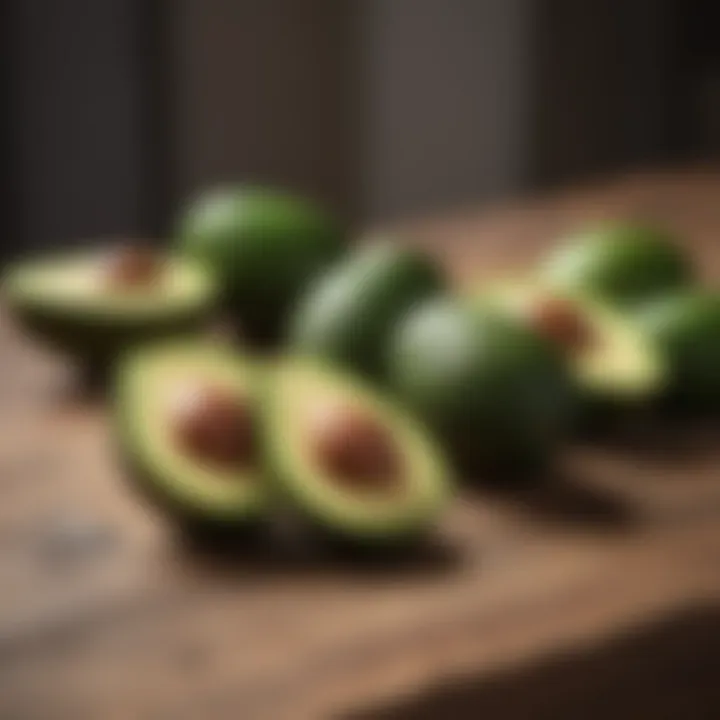
Intro
Avocados are a beloved fruit, celebrated for their creamy texture and nutritional benefits. However, keeping whole avocados fresh presents a challenge for many. Once cut, their flesh oxidizes and turns brown swiftly, which diminishes their appeal. This article sheds light on methods to prolong the freshness of whole avocados and prevent unnecessary waste. By understanding the science behind avocado ripening and applying specific storage techniques, you can ensure these fruits remain enjoyable longer.
Understanding Avocado Ripening
The ripening process of avocados is a complex chemical phenomenon. Ethylene gas is a key player here, stimulating the ripening. Avocados ripen even after harvest. They start at a hard texture and gradually soften if stored appropriately. Understanding this process is vital for selecting the perfect time to consume your avocados.
Factors Influencing Ripening
- Temperature: Warmer temperatures accelerate ripening. Ideal temperature for avocados is between 60 to 75°F (16 to 24°C).
- Ethylene Exposure: Placing avocados near ethylene-producing fruits, like bananas or apples, promotes quicker ripening.
- Storage Environment: Humidity levels also impact ripening. A well-ventilated area keeps avocados from spoiling too quickly.
Effective Storage Techniques
To maintain the freshness of whole avocados, it’s essential to employ effective storage techniques. Depending on the condition of the fruit, different methods will be effective.
Room Temperature vs. Refrigeration
- Room Temperature: If avocados are unripe, store them at room temperature. Check daily for ripeness; once they yield slightly to pressure, they are ready to eat.
- Refrigeration: Once ripe, avocados can be stored in the refrigerator. This significantly slows down the ripening process and extends their usability. The ideal temperature for storing ripe avocados is around 40°F (4°C).
Tip: To further prolong freshness, consider storing ripe avocados in a dedicated produce drawer that maintains humidity without excessive moisture.
Tips for Maximizing Shelf Life
To ensure the best flavor and texture from your avocados, consider the following:
- Keep Them Whole: When possible, avoid cutting avocados until just before consumption. This preserves their freshness.
- Use Airtight Containers: For those who must cut the avocado, use an airtight container. This minimizes oxidation and retains flavor.
- Citrus Juice: Applying lemon or lime juice to exposed flesh can inhibit browning, thanks to citric acid’s antioxidant properties.
Ending
By understanding the nuances of avocado ripening and applying the right storage techniques, you can prolong the shelf life of whole avocados effectively. These fruits are not only a delicious addition to meals but also a valuable asset in your kitchen, provided they are stored properly. Adopting these methods will enhance your culinary experience and reduce food waste.
Understanding Avocado Ripening
Avocado ripening is a critical process that determines the fruit’s taste, texture and condition. Understanding it is fundamental for those seeking to keep whole avocados fresh. The ripening process involves various scientific and environmental factors that can influence the fruit’s quality. By grasping the principles of ripening, homeowners and culinary enthusiasts alike can make informed decisions on storage and preservation. This knowledge not only helps in prolonging freshness, but it also enhances the overall experience of enjoying avocados.
The Role of Ethylene Gas
Ethylene gas plays a significant role in the ripening of avocados. This natural plant hormone is produced by avocados as they ripen. It triggers the biochemical processes that soften the fruit and elevate its flavor. When avocados are stored together, the ethylene gas emitted by one fruit can accelerate the ripening of its neighbors. This phenomenon can be useful for those looking to speed up ripening for immediate use. However, it also poses a challenge for those wishing to slow down the ripening process to extend shelf life. Understanding how ethylene works is essential for achieving desired ripeness when handling avocados.
Factors Influencing Ripening
Several factors contribute to the ripening process of avocados. These include temperature, light, and humidity. All three elements must be considered to ensure the preservation of freshness.
Temperature
Temperature affects the rate of enzymatic reactions involved in ripening. Generally, avocados ripen faster at higher temperatures. Storing avocados at room temperature is ideal for ripening, while refrigeration can slow down this process significantly. However, too much heat can lead to overripening or spoilage. Thus, maintaining a balanced temperature is crucial for optimal ripening. It is a popular choice for ensuring that avocados maintain their flavor without becoming overly soft and mushy too soon.
Light
Light is another influential factor in ripening avocados. Exposure to direct sunlight can accelerate the ripening process. However, avocados stored in too much light may become overripe without producing the desired flavor profile. Therefore, keeping avocados in a cool, dark place can be beneficial, allowing for a more controlled ripening process. This protects them from unwanted acceleration while maximizing taste and texture.
Humidity
Humidity also plays a vital role in the preservation of avocado quality. High humidity levels can lead to mold growth, while too little humidity may cause the fruit to dry out. Maintaining a balanced humidity level helps retain moisture and prevent spoilage. It is a beneficial choice as it promotes a healthy ripening environment. The unique feature of humidity in this context is its direct influence on the fruit's shelf life and quality, as avocados are sensitive to extreme conditions.
"Understanding the ripening process of avocados aids not only in their conservation but also in enhancing the culinary experience."
Overall, recognizing how these factors affect ripening provides valuable insight for anyone interested in keeping whole avocados fresh. Carrying out best practices in these areas leads to extended shelf life and improved quality of avocados.
Selecting the Right Avocado
Choosing the right avocado is crucial for enhancing your experience with this fruit. The flavor, texture, and overall culinary potential stem from the ripeness and variety of the avocado you select. An avocado that is too ripe will not last long, while one that is underripe may not taste good at all.
Identifying Ideal Ripeness
When selecting avocados, understanding the signs of ideal ripeness is key. A ripe avocado yields slightly under gentle pressure and has a darker color, specifically for the Hass variety. If it feels hard, it is likely underripe. Conversely, if it feels overly soft or mushy, it may be overripe or even spoiled.
Consumers should consider the timing of their intended use. If you plan to eat the avocado the same day, a ripe one is suitable. For longer storage, choose one that is still firm.
Varietal Differences
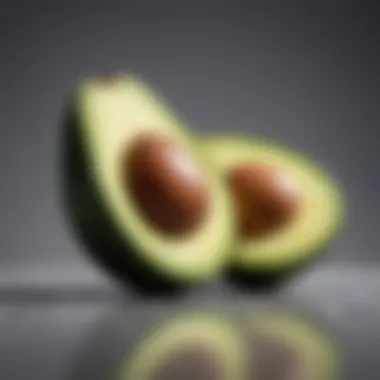
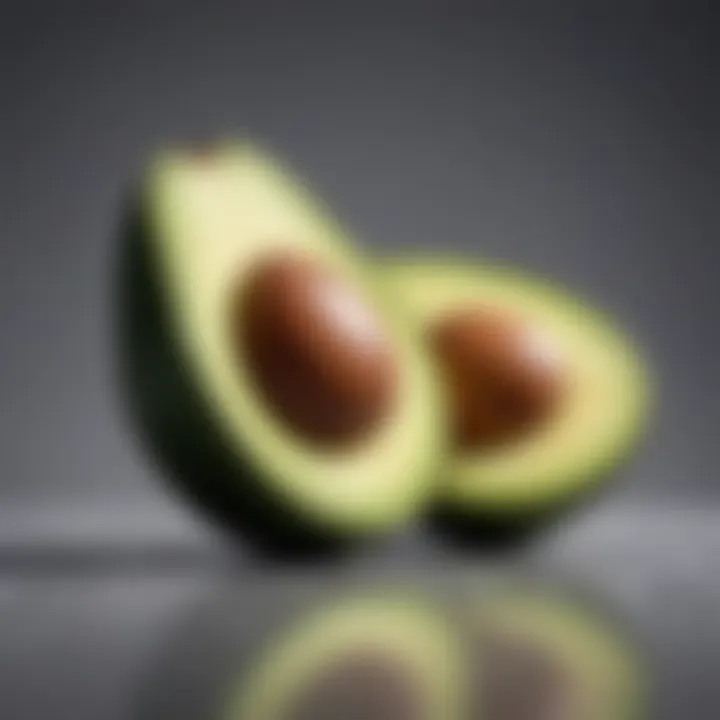
Understanding the varietal differences among avocados can also guide your selection. Each type has unique flavor profiles and textures that can influence your culinary applications.
Hass vs. Fuerte
The Hass avocado is known for its rich flavor and creamy texture, making it a popular choice among consumers. Its darker skin becomes bumpy when ripe, indicating that it is ready to eat. This variety also has a higher oil content, which contributes to its delicious taste.
On the other hand, the Fuerte avocado has a smoother, lighter green skin and a milder flavor. While it is less common, it offers a unique taste experience. Fuerte avocados are typically larger and tend to be slightly more resilient to temperature changes than Hass avocados. For most culinary needs, Hass is often favored for its flavor intensity.
Other Varieties
Besides Hass and Fuerte, there are many other varieties of avocados, such as Bacon and Pinkerton, each with its own characteristics. For example, Bacon avocados have a milder flavor and can be larger, while Pinkerton avocados provide a higher flesh-to-seed ratio, making them potentially more appealing in recipes.
When exploring these varieties, consider the specific culinary purposes they serve. Some varieties may excel in guacamole, while others shine in salads or as toppings. Understanding these differences allows you to make informed decisions when selecting avocados for various dishes.
In summary, selecting the right avocado is a vital aspect of keeping them fresh and ensuring optimal flavor and texture. By properly identifying ripeness and understanding varietal differences, you'll enhance your culinary experience with this nutritious fruit.
Optimal Storage Solutions
Understanding how to store avocados properly is crucial for extending their freshness and ensuring maximum taste. Avocados are unique in their ripening process, influenced by environmental conditions. Therefore, optimal storage solutions help in slowing down or managing ripening efficiently, allowing you to enjoy avocados at their peak.
When considering storage, one must balance not just the temperature, but also the airflow and light exposure. Both room temperature and refrigeration play significant roles in how avocados mature and retain their flavor. These storage methods can also determine how long these fruits preserve their nutritional benefits. Let's explore the benefits of each.
Room Temperature vs. Refrigeration
Storing avocados at room temperature allows them to ripen naturally. This method is ideal if the avocados are unripe. Typically, a dark, cool place, away from direct sunlight, helps keep them fresh longer.
- Benefits of Room Temperature:
- Encourages natural ripening: Deliciously softer texture.
- Suitable for unripe avocados: Ensures even ripening before consumption.
However, if the avocados are already ripe, room temperature can lead to spoilage quickly. In such cases, refrigeration is more effective.
Refrigeration slows down the ripening process significantly, making it an ideal option for ripe avocados.
- Benefits of Refrigeration:
- Prolongs freshness: Keeping avocados ripe longer.
- Reduces spoilage rates: Minimizes the risk of over-ripening.
As a general principle, choose room temperature for unripe avocados and refrigeration for ripe ones.
Best Practices for Refrigeration
To maximize the benefits of refrigeration, follow several best practices. Let’s outline key actions to take when storing avocados in the fridge:
- Wrap Ripe Avocados:
Wrap ripe avocados in plastic cling wrap to help keep them from browning due to exposure to air. - Use Airtight Containers:
If you have cut avocados, store them in airtight containers. Ideally, add some lemon juice or lime juice to minimize oxidation and preserve color. - Keep Whole Avocados Whole:
Do not slice avocados until you're ready to eat or use them. This will keep them fresher for longer. - Store in Crisper Drawer:
Place the avocados in the crisper drawer of your refrigerator where they are less exposed to air.
Proper refrigeration techniques can extend the shelf life of avocados by several days.
By adopting these practices, you will greatly enhance the longevity of your avocados, minimizing waste and promoting better culinary experiences.
Methods to Slow Down Ripening
Slowing down the ripening of avocados is essential for anyone looking to extend their shelf life and enjoy the fruit when it’s at its best. Avocados are notorious for their short window of optimal ripeness. Once they begin to soften, they can quickly transition from perfect to overripe. Therefore, understanding the methods to slow this natural process can significantly lessen waste and improve your culinary experience.
The strategies outlined in this section focus on practical, accessible techniques that can be easily implemented in the home. By utilizing these methods, individuals can manage their avocado supply, ensuring they have fresh avocados available when needed.
Using Plastic Wrap
One of the simplest yet effective ways to slow down the ripening of whole avocados involves the use of plastic wrap. Wrapping an avocado tightly with plastic wrap helps to create a barrier against oxygen. Oxygen is a key factor in the ripening process, and by limiting its exposure, you can slow down how quickly the fruit ripens.
When applying plastic wrap, ensure that it adheres closely to the skin of the avocado. This reduces air pockets and minimizes exposure to ethylene gas, which the fruit emits as it ripens.
It is crucial to note that the plastic wrap should not be too loose, as this can lead to continued oxidization. If you are storing multiple avocados, wrap each one individually. This approach enhances the effectiveness of this method and maintains the freshness of each fruit longer.
Oil Coating Technique
Another interesting method of preservation is the oil coating technique. Applying a thin layer of vegetable oil or olive oil to the skin of an avocado creates a seal. This oil barrier acts similarly to the plastic wrap in that it limits exposure to oxygen and moisture loss, both critical factors in the ripening process.
To apply this technique, simply gently rub the oil over the entire surface of the avocado. Avoid using too much oil; a small amount is effective. This coating can also add an interesting flavor to the avocado when used in culinary applications later.
Keep in mind the storage conditions; this method works best when combined with refrigeration. By slowing down the ripening and optimizing the environment, you achieve better longevity of the fruit.
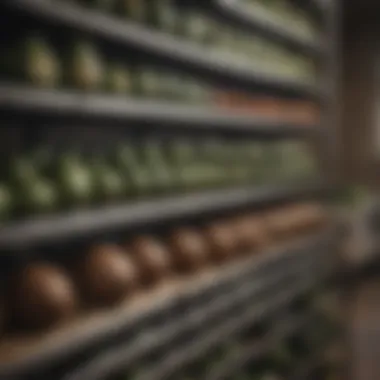

Monitoring Freshness
The process of monitoring freshness is essential when it comes to keeping whole avocados in optimum condition. Whole avocados can degrade rapidly if not observed closely. Understanding key indicators of spoilage can help individuals decide timely when to draw upon their fruits for consumption. By gauging the freshness of avocados effectively, one can not only enjoy them at their peak flavor but also reduce waste, thus maximizing the value of every purchase.
Signs of Spoilage
Recognizing signs of spoilage is crucial for determining the usability of avocados. Several indicators can suggest that an avocado may have gone bad:
- Surface Bruises: Inspect the skin for dark or soft spots. These are signs that the flesh inside might also be damaged or spoilage may have started.
- Color Changes: A fresh avocado usually has a vibrant green color. If it turns brown or black in certain areas, particularly under the skin, it may be a sign of decay.
- Odor: A strong, sour smell emanating from an avocado indicates spoilage. Fresh avocados have a mild, earthy scent.
- Texture: If the flesh feels overly mushy or has an unusual grainy texture when pressed gently, it may be time to discard it.
Be mindful of these signs to prevent unintentional consumption of spoiled avocados.
When to Consume
Timing is everything when it comes to enjoying avocados. They are best consumed when they are perfectly ripe. Here are a few guidelines on when to eat them:
- Ripeness at Purchase: If you selected avocados that are ripe at the time of purchase, consume them within a few days. Keeping an eye on them daily is important.
- Late Stage Ripeness: If you notice they are soft but not spoiled, use them in your recipes or dishes that require softer textures, such as guacamole or dressings.
- Storage Duration: Whole avocados can typically last up to one week when stored properly, so aim to eat them well before that week is up.
Eating avocados while they are still fresh assures maximum nutrient content and flavor, enhancing overall culinary experiences. Remember that when you monitor and react promptly to signs of spoilage, you can ensure a delightful use of your avocados.
Creative Use of Overripe Avocados
Overripe avocados can be a nuisance. However, instead of discarding them, consider their potential for culinary creativity. By utilizing overripe avocados, you can minimize food waste, capitalize on their rich flavors, and enhance various dishes. This section aims to inform you of effective and delicious ways to integrate overripe avocados into your meals, especially in smoothies and baking.
In Smoothies
Overripe avocados add a creamy texture and subtle flavor to smoothies. Their high content of healthy fats contributes beneficial nutrients that can elevate your drink's health profile. Integrating overripe avocados into smoothies is straightforward. Simply blend them with other ingredients. Consider combining overripe avocado with spinach, banana, and a splash of almond milk for a nourishing beverage. This combination enhances not only texture but also nutritional value.
Here are key tips for making a great smoothie with overripe avocados:
- Use fresh fruits: Pair the avocado with fruits like berries or mango to create a pleasant taste contrast.
- Experiment with flavors: Try adding cocoa powder or a spoonful of peanut butter for added richness.
- Balance the consistency: If the smoothie is too thick, add more liquid until you reach your desired consistency.
The end result is often a smooth, filling, and nutritious drink that harnesses the benefits of overripe avocados without wasting them.
In Baking Recipes
Baking with overripe avocados is another brilliant way to utilize them. Their creamy nature serves as a substitute for butter or oil in many baking recipes. This substitution not only lowers saturated fat content but increases the nutritional quality of baked goods.
Overripe avocados can be used in items like brownies, muffins, or pancakes. For instance, a simple recipe is to merge mashed avocado with the usual wet ingredients in a brownie mix. The result is a fudgy, moist texture that is hard to distinguish from the traditional version.
Consider these points when incorporating overripe avocados into baked goods:
- Mash well: Ensure the avocado is fully mashed to avoid lumps in your mixture.
- Adjust sweetness: Because avocados are creamy but not sweet, you may need to adjust sugar levels in your recipe.
- Monitor baking time: Avocado-based recipes might require slight adjustments in baking time compared to traditional recipes.
Using overripe avocados in baking not only reduces waste but also offers a healthful twist to your favorite recipes.
"Embracing overripe avocados transforms them from waste to wonderful, enhancing both culinary practices and sustainability."
Environmental Considerations in Storage
When it comes to keeping whole avocados fresh, thoughtful considerations regarding our environment play a crucial role. The storage methods we choose not only affect the lifespan of the fruit but also have significant implications for sustainability and resource management. This section emphasizes the ecological aspects of avocado storage and the positive outcomes of mindful avocado consumption.
Sustainability in Avocado Consumption
Sustainability focuses on meeting our current needs without compromising the ability of future generations to meet theirs. In avocado consumption, sustainable practices begin with sourcing avocados from responsible growers. Opting for avocados grown under organic certifications or those that employ anti-deforestation practices supports sustainable farming methods. These methods reduce the environmental impact and promote biodiversity.
Additionally, how avocados are stored can influence their carbon footprint. Practices such as avoiding over-purchasing and selecting appropriate storage conditions can minimize waste. For instance, storing avocados in a cool, dark place rather than a refrigerator prevents rapid ripening, allowing consumers to enjoy avocados at their peak freshness without unnecessary spoilage.
Choosing organic avocados can lead to healthier soil and ecosystems. This decision should be guided by a commitment to not only personal health but also planetary health. Consumers can research local farms or cooperatives focused on sustainable practices to make informed purchases.
Reducing Food Waste
Food waste is a critical issue globally. According to the Food and Agriculture Organization (FAO), approximately one-third of all food produced is wasted. By understanding how to store whole avocados effectively, consumers can contribute to reducing this waste.
Here are some key strategies to consider:
- Plan Purchases: Only buy avocados when you plan to use them. This helps prevent over-purchasing and subsequent spoilage.
- Track Ripening: Monitor the ripening status of avocados regularly. Eating avocados at the right time reduces the chance of them overripening and going to waste.
- Creative Uses for Overripe Avocados: Utilize overripe avocados in smoothies or baked goods rather than discarding them. This not only reduces waste but also contributes to healthy meals.
By incorporating these practices, individuals can play a part in minimizing food waste. The combination of well-planned avocado consumption and effective storage helps create a ripple effect of sustainability, significantly impacting the environment.
Advanced Preservation Techniques
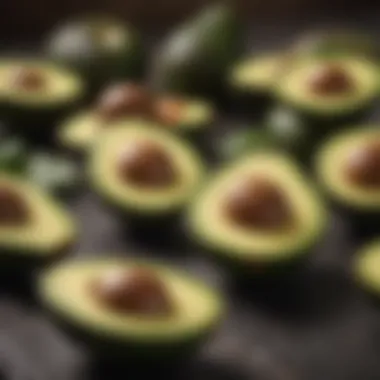

Preserving whole avocados effectively extends their shelf life and enhances the culinary possibilities for those who enjoy them. With the right techniques, you can reduce food waste and maintain the quality of these fruits. Advanced preservation methods not only help in maintaining freshness but also in retaining the rich texture and flavor avocados are known for.
Vacuum Sealing
Vacuum sealing is a highly effective method for preserving whole avocados. This technique works by removing air from the packaging, thus minimizing oxidation, which is a primary factor in spoilage. When avocados are cut or exposed to air, they quickly turn brown due to the oxidative process. Vacuum sealing slows down this reaction significantly.
Benefits of Vacuum Sealing:
- Extended Shelf Life: Whole avocados can last several weeks longer compared to storage without vacuum sealing.
- Flavor Retention: The absence of air helps keep the avocado's unique flavor intact, providing a fresher taste.
- Convenience: You can prepare avocados in batches and seal them for future use, saving time and effort later.
To vacuum seal avocados, follow these steps:
- Choose Ripened Avocados: Use avocados that are at peak ripeness for the best flavor.
- Wash and Dry: Rinse them under cold water and pat dry with a clean cloth.
- Vacuum Package: Place them in a vacuum-sealable bag, ensuring minimal space around each fruit. Use a vacuum sealing machine to remove the air.
- Store Properly: Keep the sealed avocados in a cool, dark place, or in the refrigerator for optimal results.
Freezing Whole Avocados
Freezing whole avocados is another effective advanced preservation technique. While freezing can alter the texture, it is a practical option for long-term storage, especially when avocados are abundant and prices are lower.
Steps for Freezing Whole Avocados:
- Select Quality Fruits: Make sure to choose unblemished, ripe avocados.
- Preparation: Wash the avocados and optionally cut them in half, removing the pit for quicker freezing.
- Wrap Tightly: Wrap each half or whole avocado in plastic wrap or aluminum foil to prevent freezer burn. Alternatively, use freezer-safe bags, squeezing out excess air.
- Label and Date: Properly label the packaging with the date to keep track of freshness.
- Freezing: Place the wrapped avocados in the freeze, where they can last up to six months.
By employing vacuum sealing or freezing, homeowners can take advantage of avocados at their peak ripeness while minimizing waste. Each method has its considerations and benefits, and choosing the right one depends on individual needs and consumption habits.
"Using advanced preservation techniques allows avocado lovers to enjoy their favorite fruit with minimal waste and maximum flavor."
For more detailed information on food preservation techniques, including avocados, you can visit Britannica or Reddit.
By incorporating these methods into your storage routine, you maximize the utility and enjoyment of avocados throughout the week.
The Science of Avocado Longevity
Understanding the science behind avocado longevity plays a crucial role in preserving freshness. Avocados have a unique composition that influences how long they stay palatable and nutritious. Exploring this subject allows both consumers and culinary enthusiasts to make informed decisions regarding storage and handling.
Chemical Composition
Avocados are rich in fats, primarily monounsaturated fats, which contribute to their creamy texture and distinct flavor. The main component, oleic acid, not only provides health benefits but also affects their shelf life. In addition to fats, avocados are high in vitamins C, E, and K, as well as various B vitamins, all of which have antioxidant properties. These components play a role in slowing down deterioration.
Moreover, avocados contain phenolic compounds that help combat oxidative stress. This is significant for maintaining their quality over time. The high oil content can protect the fruit from spoilage by creating a barrier that limits exposure to air and moisture. Understanding these elements helps in selecting the right storage methods that play into these natural characteristics.
Impact of Oxidation
Oxidation is a natural process that affects all fruits, including avocados. Once cut, exposure to oxygen triggers enzymatic reactions that lead to browning, greatly impacting aesthetic appeal and flavor. This process begins rapidly, often within minutes. While the effects of oxidation can be mitigated, the understanding of this process is key to maximizing avocado’s freshness.
To combat oxidation, various techniques can be employed. Here are a few effective methods:
- Lemon or Lime Juice: Applying citric acid by rubbing the flesh with lemon or lime juice can reduce browning
- Onion Storage: Storing cut avocados alongside an onion can also slow oxidation due to the sulfur compounds in onions
- Plastic Wrap: Tight wrapping to limit air exposure can minimize oxidation effects
"Proper handling of avocados, considering their chemical makeup and susceptibility to oxidation, can significantly extend their preservation."
Overall, understanding the science behind avocado longevity enables effective storage solutions, reducing waste and maximizing consumption. Such knowledge empowers consumers to maintain the quality of this prized fruit.
Consumer Trends and Preferences
Understanding consumer trends and preferences is essential in the context of keeping whole avocados fresh. The rise in health consciousness has significantly driven demand for fresh produce, particularly avocados. Consumers prefer fresh and natural food items that align with their dietary needs. Fresh avocados are not just a trend; they represent a lifestyle choice for many.
Market Demand for Fresh Produce
The market demand for fresh produce has surged over the past decade. This shift is characterized by an increasing appreciation for the nutritional benefits of fresh fruits and vegetables. Avocados, known for their healthy fats and versatility, have become a staple in many diets.
Several factors influence this demand:
- Health Awareness: More people are aware of the health benefits linked with consuming fresh food.
- Culinary Trends: The increased popularity of plant-based diets incorporates avocados in various dishes.
- Accessibility: Stores are now providing better access to fresh produce, including avocados, catering to this growing demand.
The implications of these trends are clear. As consumers prioritize freshness, the importance of maintaining the quality of whole avocados becomes paramount. Retailers must consider storage practices and supply chain efficiency to meet customer expectations.
Influence of Social Media on Consumption
Social media plays a crucial role in shaping consumer behavior. Platforms like Instagram and Facebook have transformed how consumers discover and interact with food products.
The phenomenon can be seen in the following ways:
- Visual Appeal: Beautifully presented avocado dishes often go viral. This encourages consumers to experiment with avocados in their meals.
- Influencers: Food influencers share recipes and tips on using avocados, sparking interest and demand.
- Community Engagement: Groups focused on healthy eating create communities around fresh produce, further driving preference for items like avocados.
As social media continues to influence eating habits, it becomes increasingly important for consumers to understand how to retain the freshness of avocados. In this digital age, the process of maintaining avocados encompasses not just storage techniques but also the practices shaped by consumer engagement online.
"The choice to consume fresh produce is often guided by visual inspiration and community discussion on social media platforms."
In summary, both the increasing demand for fresh produce and the influence of social media significantly impact consumer preferences. As interest in avocados grows, understanding these trends will help in maximizing their freshness and ensuring they remain a desirable choice.



